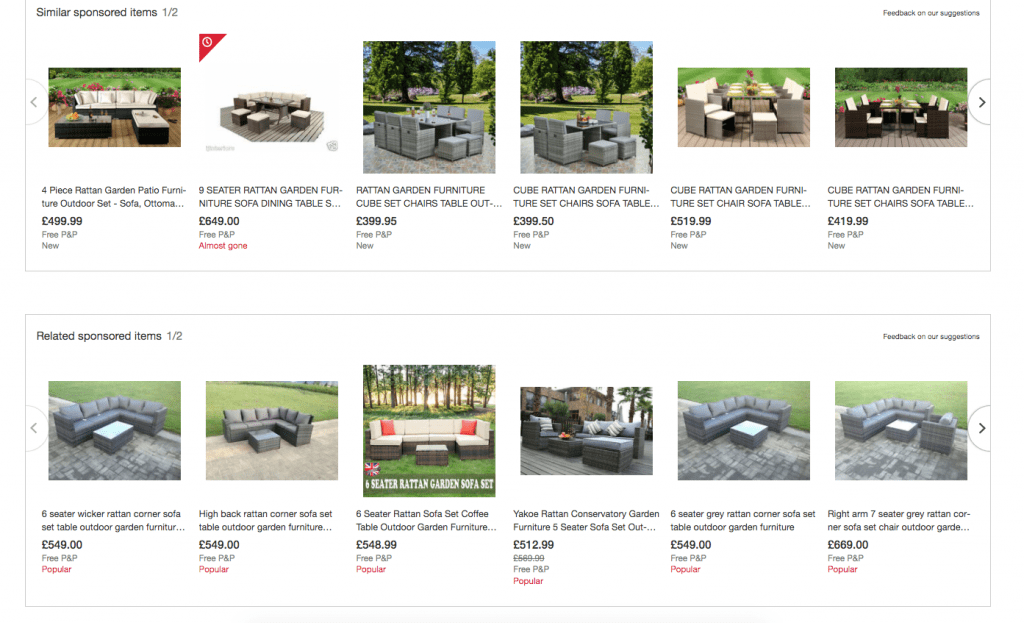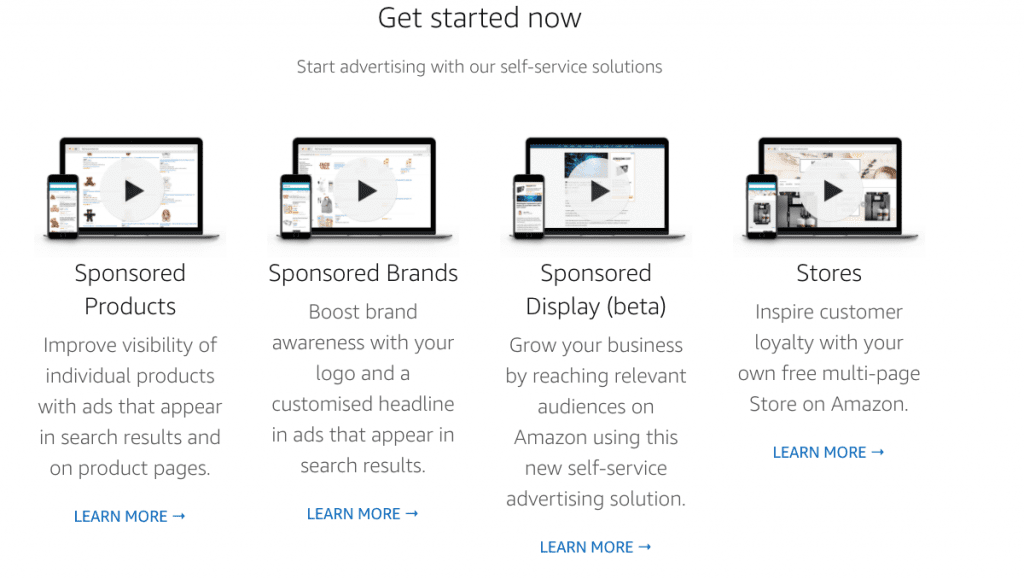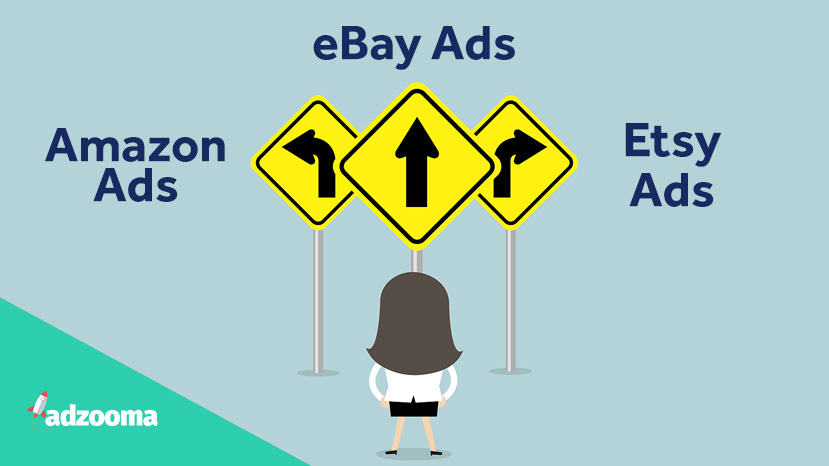Next up in the PPC alternatives series is e-commerce. If you’ve got an online store, or just want to sell your products online, it’s best to market your business on a platform where your customers are looking to buy.
Google Shopping Ads are worth bearing in mind but are highly competitive. So let’s look at the places where your audience is already narrowed down.
Etsy
What is Etsy?
Etsy is an e-commerce site dedicated to handmade and vintage items and craft supplies. It’s home to many small businesses, often run by a single person, who make their products to order with a lot of love and care.
You can find several different things for sale on Etsy. The main categories include home decor and furniture, toys, art, crafts, jewellery, and other handmade items.
How does it work?
There are two different ways to advertise: on Etsy itself and with their Offsite Ads.
Etsy Ads
Running an Etsy Ads campaign means your product or service is only shown to users on the Etsy platform. Whilst previously Google Shopping was included, this is now part of their Offsite Ads.
They’re pretty easy to set up as they take your existing product listing and promote it, meaning the majority of the work comes when adding new things to your store.

Offsite Ads
Offsite Ads are only available on Etsy and have been designed with Etsy shop owners in mind. They use your Etsy ad budget to promote your products on sites such as Google, Facebook, Instagram, Pinterest and Bing. This gives your Etsy shop a much bigger reach than the option above and means you don’t have to take the time to set up separate accounts for each platform.
Sellers are automatically enrolled in Etsy’s offsite ads as there are no upfront costs and you only pay when you make a sale. If you make more than $10,000 per year from your Etsy shop, you’re required to participate but you do get a discounted advertising fee. This will only affect a small portion of sellers, but some may not like being strong-armed which is understandable.

Why run ads on Etsy?
Anyone with products to sell can create a store on Etsy. It’s free to set up, but there are seller fees attached. For example, it costs 15p to list an item and, once sold, Etsy takes 5% of the listed price as a translation fee. So, things can get pricey quickly making it important to list your products at a price that makes things worthwhile.
Etsy has a very dedicated userbase – if you’ve used and been impressed with the variety and choice before, it easily becomes your go-to place to browse for handmade things.
The best people to advertise on Etsy are:
- Artists who make their own unique or custom pieces
- Hobbyists who are looking to now make money
- Sellers who want to connect with their customers individually
Etsy offers a very niche audience – but if that audience is right for your business, you’re laughing.

How much does it cost?
Etsy ads work on a cost-per-click bidding system so you’ll be charged a small amount every time someone clicks on your ad. The cost is determined by how much competition there is.
You set a daily budget between $1– $50 and Etsy won’t spend over that on a given day. If you’re a newbie, it’s best to disable auto-bidding until you have some data to look at. Etsy lets you see exactly where your money is being spent, alongside a breakdown of each product’s promotion.
There’s also a handy feature to set up discount codes. These are great as extra little incentives which you can promote on social media. They can also be emailed to people who have added your product to their basket but not completed the purchase, or if someone favourites your item. The email code is dropped in their inbox, with the aim of persuading them to make the purchase. This is Etsy’s version of retargeting.
Adzooma’s experience
As Adzooma is a PPC software, we limit our advertising to platforms which lend themselves to our product. We also spend our time putting customers together with other digital marketing services to benefit their business via our Marketplace.
Despite us not running ads on Etsy, eBay or Amazon at current, our team has a wealth of experience that they’re happy to share.
Adzooma’s Paid Social Manager, Matt Hogan, shares his past experiences on running Etsy ads:
“My experience with Etsy ads is relatively straight forward. Certainly when you compare to more in-depth platforms like Google and Facebook. The bulk of the leg work is actually done when you add the product to the actual store as that then becomes the ad. So making the item title/description as appealing as possible is very important.
I’d recommend anyone who’s using Etsy to test out their ad platform. I’ve seen increases in sales from doing so in the past and there’s no reason others won’t as well. Start on a smaller budget, spend time learning Etsy’s tools and features, as well as their reports, and you’re likely to see success.”
eBay
What is eBay?
eBay is a multinational e-commerce site that sells pretty much everything. There’s not many things you can’t find on eBay, which makes it a great site for bargain hunters.
To give you an idea of its categories, the top ones include:
- Fashion
- Electronics
- Sports, Hobbies & Leisure
- Home Garden
- Motors
- Collectables & Art
- Business, Office & Industrial Supplies
- Health & Beauty
It operates on an auction system that allows users to bid against one another. Sellers can also set ‘buy now’ prices that allow customers to purchase a product straight away. So, whilst eBay made its name as an auction site, it has now become home to e-commerce stores too.
How eBay Ads work
Advertising on eBay is straight forward. You pay to promote your listing and your ads will be shown on the eBay website or app alongside products similar to yours.
The best thing about eBay ads is that you only pay for the ad when you make a sale. It isn’t technically PPC, but allows you to advertise risk-free to test the waters of your eBay audience.
Where and when your ads appear is based on factors like your chosen ad rate and the relevance of your item to a buyer’s search. You can access a lot of data to dig into the number of clicks and sales you’re getting. It’s also easy to switch things off which is always reassuring.
It’s easy to get started as you don’t have to find ad creatives or select keywords – everything is based off your existing listing, similar to Etsy.

The benefits of eBay
You can think of eBay as a product search engine in its own right. It offers great exposure to its sellers as its strong reputation means people naturally turn to it. Not sure where to find something? eBay will probably have it.
eBay can provide you with a great platform to build up exposure for your products. If your business proves popular, you can then spend money expanding into your own e-commerce site. But, until you have enough of a following for people to search for your product specifically, big sites like this have a lot to offer.
The disadvantages
The point of searching for alternative sites to run PPC ads is that you discover a platform that caters for your industry. By running campaigns somewhere that has a targeted audience, the chances of people being interested is a lot higher. You lose this benefit by looking to big sites such as eBay or Amazon; because you can sell anything and everything, it’s impossible to achieve that niche audience.
However, the upside is that you can piggyback on these huge companies’ reputations. But, the benefits are very similar to that of Google, Facebook and Microsoft – just a little more product-focused. It’s obviously difficult to suggest niche sites for every product that you can then run PPC ads on, but please take inspiration from this PPC alternatives series and spend some time looking for niche sites for your industry – cheaper clicks await you.
Adzooma’s experience
Our Head of Digital Acquisition here at Adzooma, Will Haswell, worked on eBay campaigns at a previous agency. (If you’re looking for an agency, you’ll find some great options on our Marketplace.) He said that some of his clients e.g an outdoor clothing brand received a good amount of traffic from their eBay ads which resulted in strong incremental growth.
“I don’t think there are many brands or industries that couldn’t do well on eBay. If they’re already advertising online, it simply provides additional exposure for them. If your business is product-based and you’re looking to add a new marketing channel into your mix, eBay is worth a look.”
Amazon
What are Amazon Ads?
Amazon Ads operate on a traditional PPC model. You bid on keywords and get listed in a “Sponsored Products’ slot on the search results. As its a pay-per-click model, you only pay if your ad gets clicked. Simple.

How they work
Ads are ranked based on their profit rather than CTR. After all, it’s Amazon’s job to serve results it thinks its users are most likely to buy. However, Amazon ads see a 10% conversion rate in comparison to Google’s 1-2%, largely due to the intent of its audience.
Amazon splits its PPC ads into two types of sellers: Seller Central and Vendor Central. The difference between them is that Seller Central is designed for small businesses who want to sell directly to customers. Vendor Central is for larger manufacturers that want to sell to Amazon directly, and then Amazon sells that product on.
Amazon offers 3 different types of PPC ads:
- Sponsored Product Ads: These appear on the right and above organic search results. They’re the most common types of ad you see and are available to both Seller Central and Vendor Central sellers.
- Headline Search Ads: These are banner ads and appear at the top of pages alongside ad copy. These are available to both Seller Central and Vendor Central sellers.
- Product Display Ads: These are displayed on chosen product pages but are only available for Vendor Central sellers.

Automatic vs Manual PPC ads
Amazon caters for PPC beginners and experts. If you want, you can just tell Amazon how much you want to spend and then let its algorithm get to work. It selects your keywords for you, but obviously offers less control than the manual option. If you feel like you know what you’re doing, Amazon’s manual ads are great for perfecting your performance.
Mark Neale, Head of PPC at Adzooma, suggests starting off with Amazon’s automatic ads and then feeding that data into the manual ads at a later date.
“By letting Amazon’s algorithm kick things off for you, you can easily gather the data you need to see how you can improve your ads. Once your products have been seen by enough people, you can optimise your listings to maximise your sales. Running manual PPC ads straight away may feel like you’re scrambling around in the dark – lean on automatic ads initially to give yourself time to learn the platform and ensure a smoother start.”
Why advertise on Amazon?
Amazon has 197 million active users each month and their share of the US e-commerce market stands at 45%.
There’s a lot of competition with its huge inventory totalling more than 353 million when you include its marketplace sellers. But, studies show that Sponsored Products and Sponsored Brands clicks convert at more than three times the rate of Google Shopping ad clicks. If you need any more information, discover if Amazon ads are worth it here.
The best way to see if this is true for your products is to try it: the proof is in the pudding. The same can be said for other great marketing services found on our Marketplace.
E-commerce PPC alternatives
Advertising online doesn’t limit your reach like a physical store does. It’s important to ensure you don’t limit yourself with PPC either. There are a lot of alternatives to selling on Google out there, so take the time to try some alternatives with our other handy guides and see what sales they can bring in for your business.




